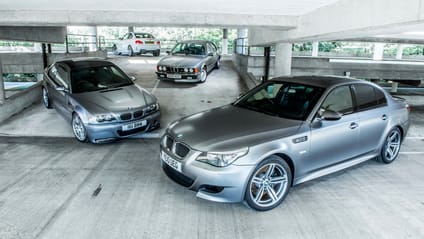
How to buy an old BMW M-Car
How can one letter hold such a fascination for petrolheads? It’s all down to past form…


BMW’s Motorsport or ‘M-Power’ division has long been a staple of the top ten most desirable on any self-respecting petrolhead’s dream list. Why? Because its machines tend to be brilliantly engineered, eminently usable daily drivers, with the ability to put a smile on your face on any journey. They also tend to be relatively subtle (M3 GTS excepted), reliable and properly quick. They’re also within reach. The good thing about having a long, mass-produced history is that there are loads of older M-cars that are now very reasonable money. Which means you can have a little piece of legendary metal in the garage, without breaking the bank…
Photography: Rowan Horncastle
This feature was originally published in the December 2015 issue of Top Gear magazine.
Founded in 1972, BMW Motorsport is actually a fully fledged subsidiary of BMW originally intended to handle its racing exploits, starting off with the legendary 3.0-litre CSL back in the early Seventies. It wasn’t long before ‘M’-badged and tweaked machinery (usually, engine, suspension and styling/aero upgrades) arrived, though 1978’s M1 was more a racing car converted to road use than an upgraded road car, something that is probably more realistically encapsulated by the M535i in 1979.
These days, it’s a legendary outfit, having made some of the most accessible ‘real-world’ performance cars ever. It supplied the 6.0-litre V12 for the McLaren F1, has competed in – and won – many kinds of motorsport and currently M-Powers (sorry) most of the BMW range in some form or another.
As with most of the famous in-house tuners, there’s been a little bit of liberty taken in terms of the badging, though. The famous ‘M’ badge also denotes ‘M’ styling and accessories, so the only ‘real’ M cars tend to have the three-striped M before the model designation (M2, M3, M4, M5, M6, etc). Anything else is lager in a champagne glass.
Advertisement - Page continues belowThe ones to look out for

The difference between duffer and desirable is a bit moot with older M-cars, as there isn’t really a bad car among them. So the usual caveats apply when looking for something that won’t lose money, or might even appreciate by a bob or two.
First, rarity. Anything limited attracts value, though we’re talking about real change, not just some of the more obscure paint and trim combos. And yes, an M1 is both fast and rare, but you’ll already find ‘POA’ on most of the listings, which means us normal humans can’t get anywhere near one.
So things like M3 CSL, CS and GTS are good bets, cars that have limited production, extra speed and geek-chic cachet – though you’ll still be looking at significant cash for any of those. Something like a good-condition M635CSi is also a decent shout – a little overlooked at the moment, but with under 6,000 built, that’s likely to change. The 1M Coupe is already making the same prices it was originally sold for in 2011 – meaning that it has bottomed out already – and looking at the relative prices of M Coupes and Roadsters, good ones are starting to creep ever upwards compared with even a couple of years ago.
Second, and rather obviously, is condition: even though there are lots of companies that can service and restore performance BMWs, an original, good-condition, early car is still worth more than something even sympathetically modified – so beware bodykits and dubious ‘upgrades’.
M635CSi (E24) 1984–1989

Number built: 5,859
Average value: £20k–£30k (though a 50k-miler is more like £35k)
It’s an E24 Six powered by the M88 motor from the M1, so what’s not to like? With over 280bhp and a dry weight of just over 1,500kg, these GTs were no slouch back in 1984: 0–60mph in around 6.4secs and a 158mph top end. And they’re starting to look seriously good now, Paul Bracq and Manfred Rennen’s sharky-nose design entering the desirable plane of ‘retro’ rather than just ‘old’. Prices have been gently rising for a while now, and they aren’t going to get lower.
Advertisement - Page continues belowM5 (E60/1) 2004–2010

Number built: 19,522 (saloon), 1,025 (estate)
Average value: £16–20k
A saloon car with a V10? A big deal in 2005, and the E60’s 5.0-litre was matched to either a single-clutch SMG semi-auto in Europe or a 6spd manual in the US (the SMG being an option). It was quick – 0–62 in under 5 and, when derestricted, a 200mph car. Plus, you could get it in estate form in Europe, which led to some surprised pets. Best bit? It’s still affordable.
1M (E82) 2011–2012

Number built: 6,342
Average value: £40k
Called the 1M to avoid confusion with the M1 supercar, this little 1-Series Coupe was an instant hit. Bigger, wider body and specific bodykit, plus a turbocharged straight-six and manual ’box. The 1M managed 338bhp and 332lb ft, and it was a bit lighter than standard at under 1,500kg. It cost £40k when new, and prices are staying at that level for medium miles – so expect this car to start to rise very soon.
M3 CSL 2004

Number built: 1,400
Average value: £70k (£60k six months ago!)
The Coupe Sport Lightweight appeared in 2004 with either silver or black paint, 110kg lighter than the M3 and featuring a general loss of sound-deadening. It also got lots of CFRP bits – including the roof, before it was standard-fit on later M3s – better suspension and brakes plus a racier engine tune. You can ID them by the subtle ducktail bootlid and the front-bumper intake, as well as the multi-spoke 19in BBS wheels. Beware clones! Likely to become unaffordable soon.
Trending this week
- Car Review
BMW 1 Series
- Top Gear's Top 9
Nine dreadful bits of 'homeware' made by carmakers







